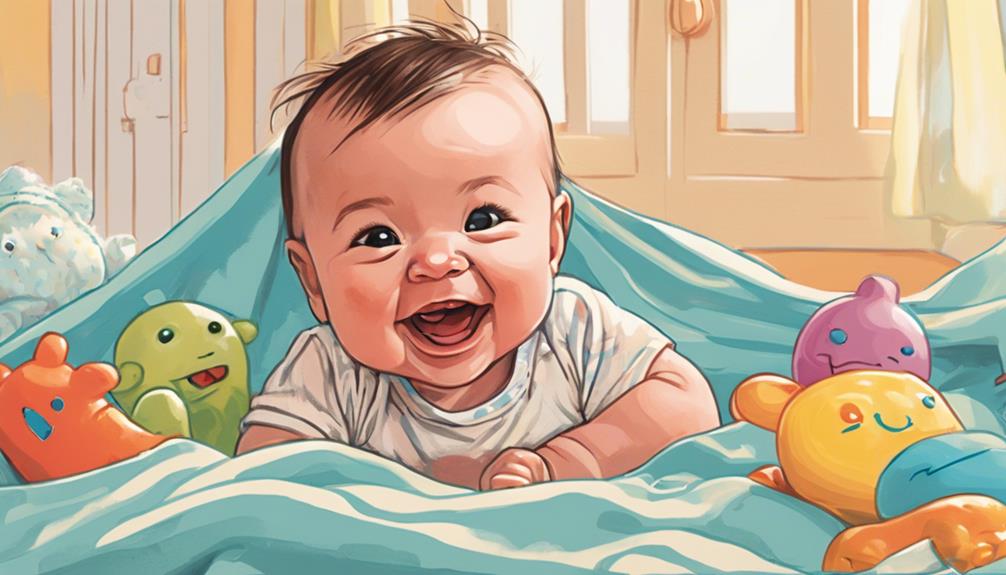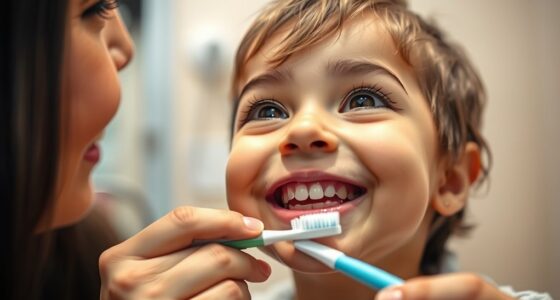Your baby's first teeth typically appear between 6 and 10 months, starting with the lower central incisors. This initial stage of teething can be exciting yet challenging. After the lower incisors, expect the upper central incisors to come in around 8 to 12 months. Following that, the lower lateral incisors usually emerge between 10 to 12 months, and the upper lateral incisors appear shortly afterward. Understanding this timeline can help you prepare for your baby's teething phase. If you're curious about what happens next in their dental journey, there's much more to discover!
Key Takeaways
- Babies typically begin teething around 4 to 7 months of age, with some signs appearing as early as 3 months.
- The first teeth to emerge are usually the lower central incisors, appearing between 6 to 10 months.
- Following the lower central incisors, the upper central incisors usually emerge between 8 to 12 months.
- The lower lateral incisors typically appear next, around 10 to 12 months of age.
Understanding Teething
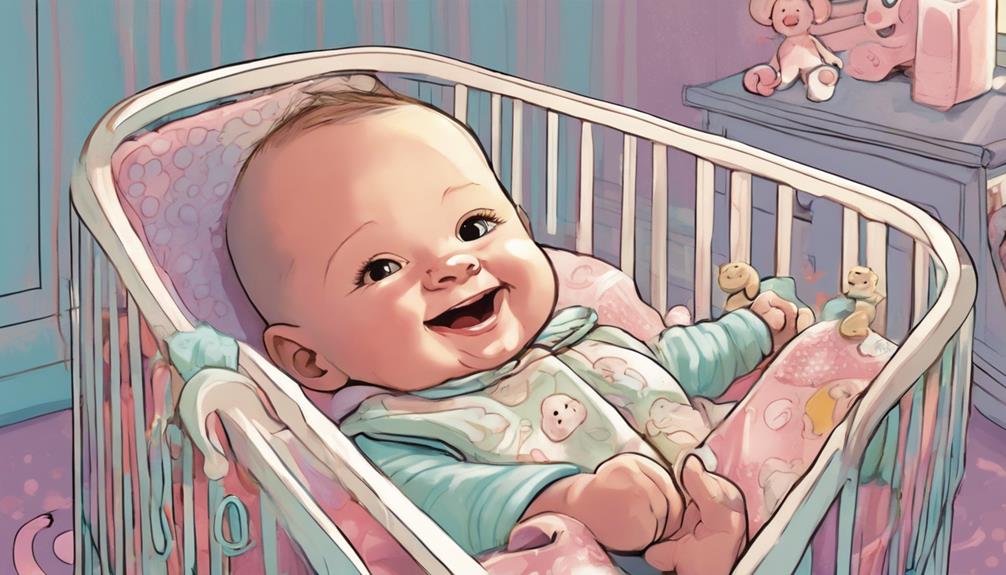
Teething is a natural process where your baby's first teeth emerge, typically starting between 4 to 7 months of age. Understanding teething helps you prepare for this milestone.
The first teeth to come are usually the lower central incisors, which appear between 6 to 10 months. Shortly after, around 4 to 8 weeks later, you can expect the upper central incisors to erupt.
As babies start teething, they may experience teething pain, which can cause discomfort. This process doesn't happen all at once; the sequence continues with lateral incisors, first molars, canines, and finally, the second molars. By age 3, most children will have all their primary teeth in place.
Keep in mind that individual teething timelines can vary considerably. Some babies may not have any teeth by their first birthday, while others might get theirs earlier than expected.
It's crucial to observe your baby's signs and symptoms during this time, as each child's experience with teething can differ greatly. Knowing what to expect can help you support your little one through this exciting, albeit sometimes painful, stage of development.
When Teething Begins
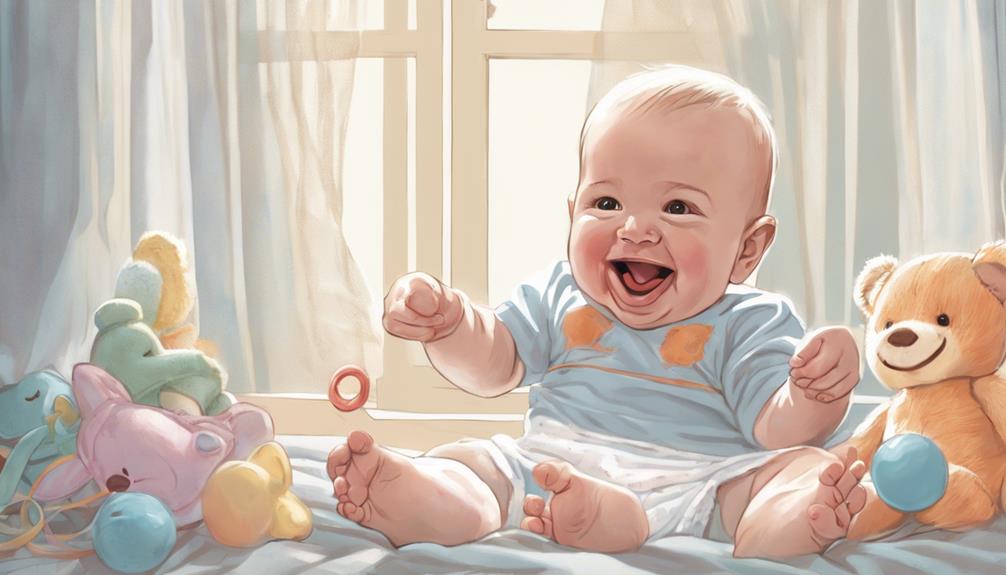
Most babies start showing signs of teething between 4 to 7 months of age, although some may surprise you by starting as early as 3 months or as late as 12 months. When teething begins, you might notice your little one becoming more irritable or drooling excessively. The age at which they get their first teeth can vary greatly.
Typically, the first teeth to erupt are the lower central incisors, appearing around 6 to 10 months. After these, the upper central incisors usually come in about 4 to 8 weeks later. This marks the beginning of the order of tooth eruption, which continues with the lower lateral incisors, followed by the first molars, canines, and second molars.
It's important to remember that some children may not have any teeth by their first birthday, and that's perfectly normal. Every baby is unique, and their teething timeline can differ widely.
As a parent, staying informed about when teething begins helps you prepare for the changes ahead and offer comfort when needed.
First Teeth to Erupt
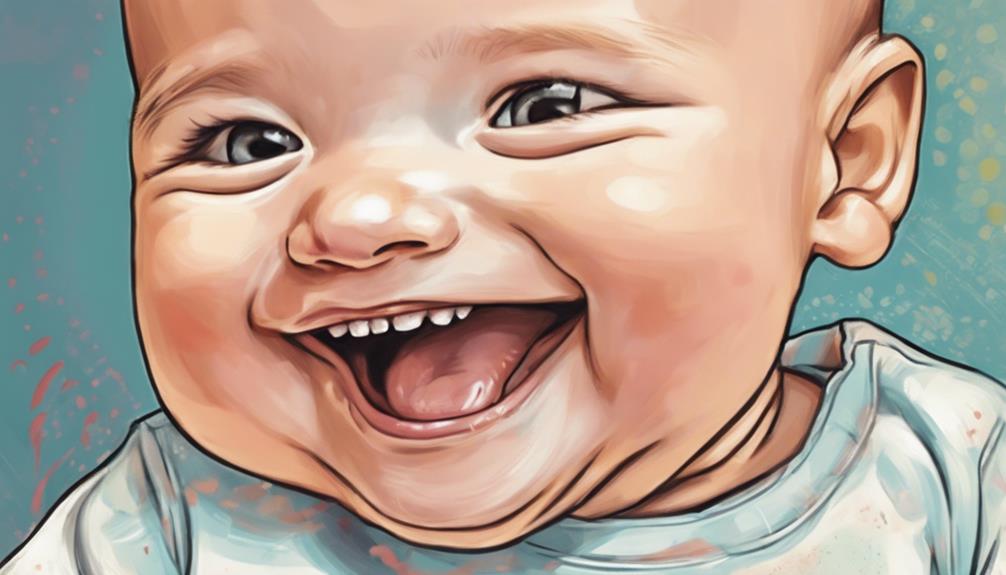
The first teeth to emerge in your baby are typically the lower central incisors, appearing between 6 to 10 months of age. These tiny teeth play an essential role in your baby's ability to eat and speak. Baby teeth eruption order can vary slightly from child to child, but the lower central incisors are usually among the first to come in. Following these, you can expect the upper central incisors to appear, followed by the lateral incisors, first molars, canines, and finally the second molars. It’s important to monitor your baby’s oral development and maintain good dental hygiene to ensure their baby teeth come in properly.
Following the lower central incisors, expect the upper central incisors to come in around 8 to 12 months.
Next in line are the lower lateral incisors, which usually erupt between 10 to 12 months, while the upper lateral incisors appear around 9 to 11 months.
As the teething process continues, the first molars typically emerge between 13 to 19 months. These larger teeth help with grinding food.
Signs of Teething
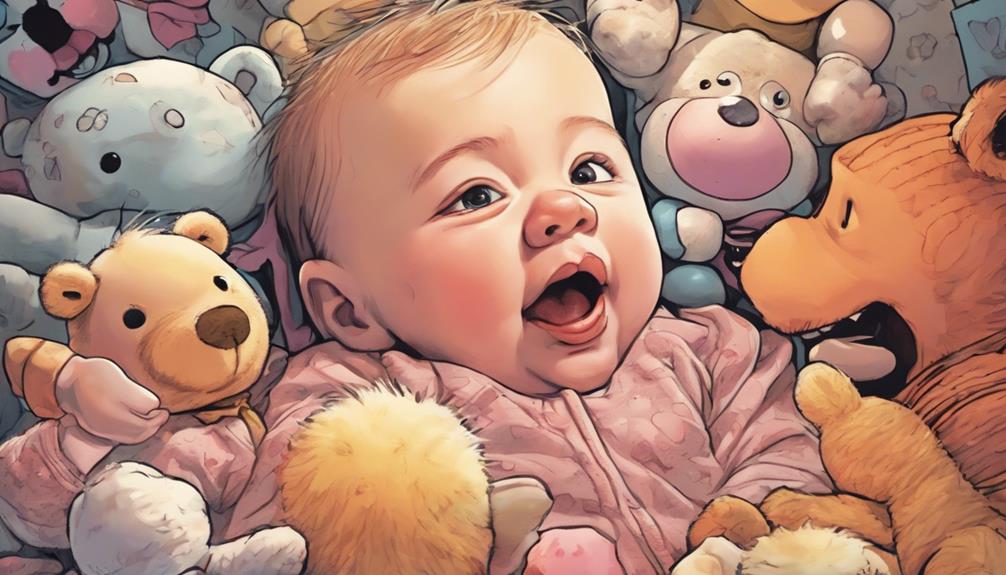
When your baby starts teething, you might notice a few common symptoms.
Increased drooling, fussiness, and a strong urge to chew on everything can signal that those little teeth are on their way.
Understanding these signs can help you manage any discomfort your baby might experience during this time.
Common Teething Symptoms
Experiencing common teething symptoms can be challenging for both babies and parents, as signs like increased drooling and irritability often emerge around 3 months of age.
When your baby is teething, you might notice excessive drooling, which is a clear sign of discomfort. This drooling can lead to skin irritation, so keep a cloth handy to wipe their chin.
Irritability is another common symptom; your little one may seem fussier than usual. While some babies manage to sail through teething without much pain, others show signs of discomfort with swollen gums that may feel tender to the touch. You might also see your baby trying to chew on objects or their own fingers to soothe their sore gums.
Additionally, disrupted sleep patterns can occur, making it hard for your baby to fall or stay asleep. Though you might notice a slight elevation in their temperature, it's generally below 102°F and shouldn't cause alarm.
Recognizing these signs of teething will help you support your baby through this challenging phase while keeping an eye on their comfort and well-being.
Managing Teething Discomfort
Managing teething discomfort involves recognizing the signs early and using effective strategies to soothe your baby during this often challenging time. You'll notice common signs like increased drooling, irritability, and a desire to chew on objects. While teething is painless for some babies, others may experience sore gums and mild discomfort.
To help you manage this phase, here's a quick reference table:
| Signs of Teething | Soothing Strategies | Products to Use |
|---|---|---|
| Increased drooling | Gently massage gums | Teething rings |
| Irritability | Offer a cold washcloth | Teething gels |
| Swollen gums | Provide a cool teething ring | Chilled fruit (for older babies) |
As you monitor symptoms, remember that a mild fever (under 102°F) and disrupted sleep patterns can be normal. However, if you notice high fever or diarrhea, it's time to consult a pediatrician, as these symptoms usually indicate other health concerns. With the right strategies, you can help ease your baby's teething discomfort effectively.
Managing Teething Discomfort
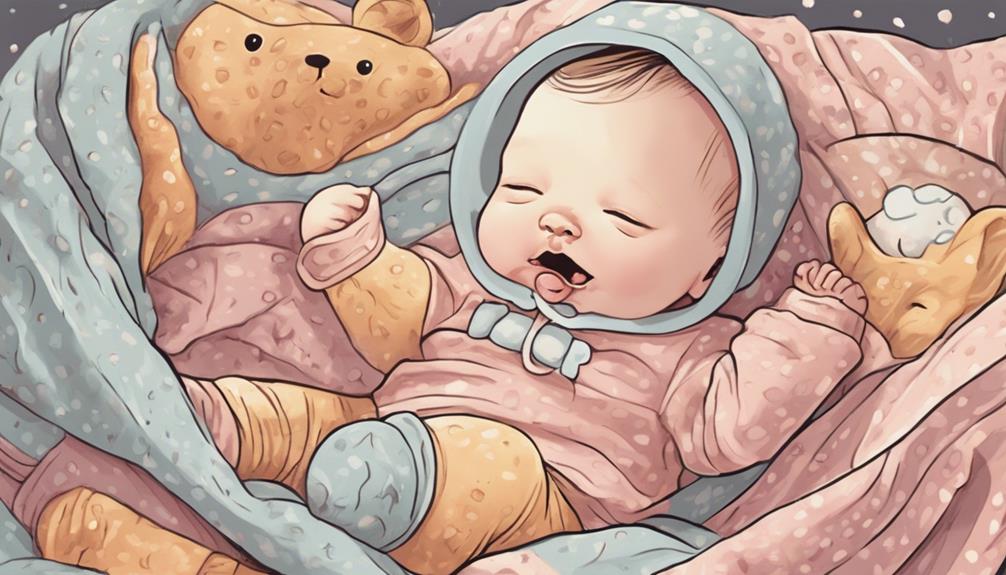
Teething can cause significant discomfort for babies, but there are effective ways to soothe their pain and make this challenging phase a bit easier. You can help by gently massaging your baby's gums with a clean finger, which can provide immediate relief.
Additionally, using chilled teething rings can be a great option, as the cold helps numb the area and reduce inflammation. Offering cold washcloths for your baby to chew on is another simple and effective remedy.
While managing teething discomfort, it's essential to monitor symptoms closely. Mild temperature elevations are common, but be aware that persistent high fever usually signals other health issues. If you have concerns about your baby's symptoms or the effectiveness of your chosen teething products, don't hesitate to consult your pediatrician for advice on appropriate pain relief options.
Lastly, keeping your baby's face clean and dry can help manage excessive drooling and prevent rashes that may develop during this time. With these strategies, you can make teething a little easier on both you and your little one.
Oral Care for Infants
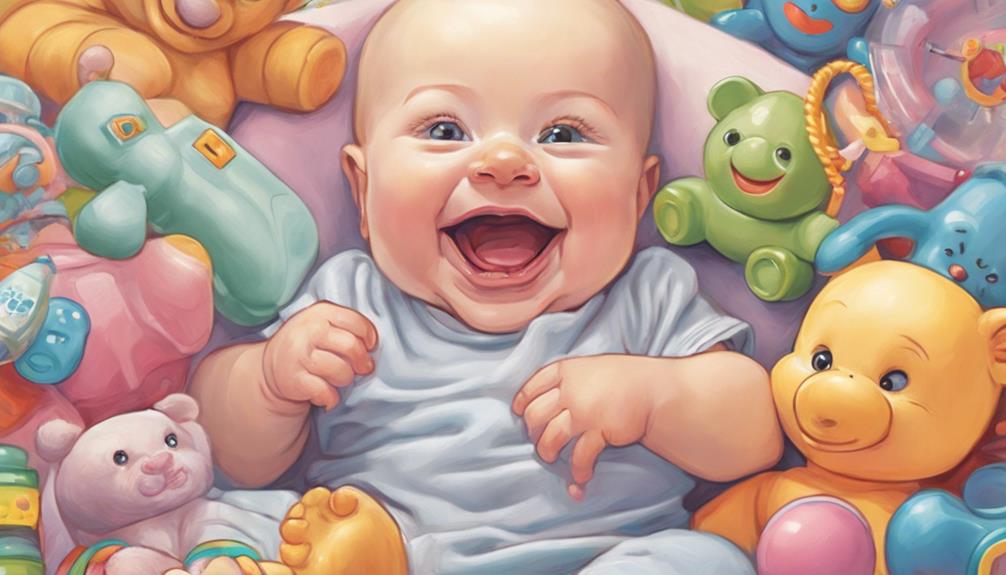
Taking care of your baby's oral hygiene starts even before their first tooth appears.
You should gently clean their gums with a soft cloth to set the foundation for good habits.
Once that first tooth pops up, it's time to introduce a soft-bristled toothbrush and fluoride toothpaste to keep their smile healthy.
Daily Gum Cleaning
Start cleaning your baby's gums with a soft, damp cloth right after birth to lay the foundation for good oral hygiene.
Daily gum cleaning is crucial, even before the first tooth appears. Gently wipe your baby's gums at least once a day to remove bacteria and prevent plaque buildup. This simple routine fosters healthy dental habits early on.
Here are three key tips for effective gum cleaning:
- Use a Soft Cloth: A clean, damp cloth is perfect for gently wiping your baby's gums, making it easy to remove any residue.
- Start Early: Begin this oral care routine as soon as your baby is born to help them get used to dental care.
- Plan for the Future: Once the first tooth emerges, switch to a soft-bristled toothbrush and use a smear of fluoride toothpaste to guarantee proper cleaning.
Don't forget to schedule your baby's first dental visit by their first birthday or within six months of their first tooth.
This visit will provide valuable guidance on your baby's dental development and hygiene practices.
First Tooth Brushing
Once that first tooth pops up, it's time to switch to a soft-bristled toothbrush and a smear of fluoride toothpaste for effective oral care. Start brushing your baby's teeth twice daily to establish a solid routine. This first tooth brushing is essential for cleaning those tiny baby teeth and getting your little one used to the process.
Even before teeth emerge, keep cleaning your baby's gums with a soft cloth to promote healthy habits. As your child grows and learns to spit, gradually increase the amount of fluoride toothpaste to a pea-sized amount. Always supervise your child while brushing until they're around 7 or 8 years old to guarantee they're using the right technique.
Teething can be uncomfortable, so make certain to be gentle during brushing. Remember, maintaining your baby's oral hygiene sets the stage for a lifetime of good dental health.
Schedule that important dental visit by your child's first birthday or right after their first tooth erupts, reinforcing the importance of caring for their teeth from the very beginning. Your commitment to oral care now will pay off in the future!
Common Teething Myths
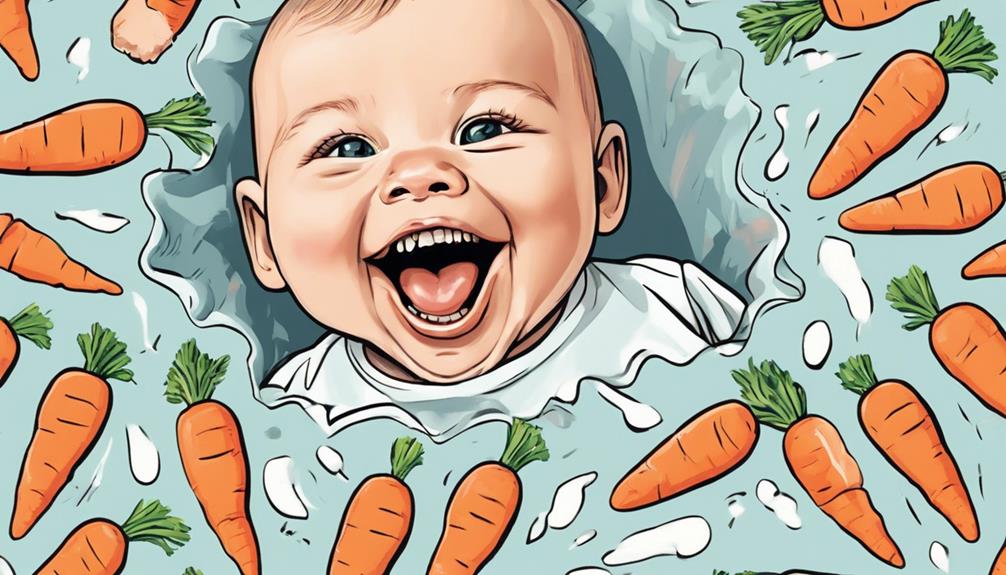
Many parents hold onto common myths about teething, leading to confusion and unnecessary worry during this developmental phase. Understanding the facts can help you navigate this time more smoothly. Here are three common myths:
- Teething Causes High Fever: While mild temperature increases are typical, a true fever above 100.4°F usually indicates an illness, not teething.
- Teething Leads to Diarrhea: There's no scientific evidence linking teething to diarrhea. If your baby has unusual gastrointestinal symptoms, consult a healthcare provider.
- All Babies Experience Significant Teething Pain: Symptoms vary widely; some infants show little to no discomfort during teething.
Additionally, many parents mistakenly believe teething can cause ear infections. In reality, the irritability and fussiness of teething might be confused with signs of an ear infection.
Finally, beware of amber teething necklaces. They pose serious choking and strangulation risks and lack scientific support for their effectiveness in relieving teething pain.
Pediatrician Recommendations
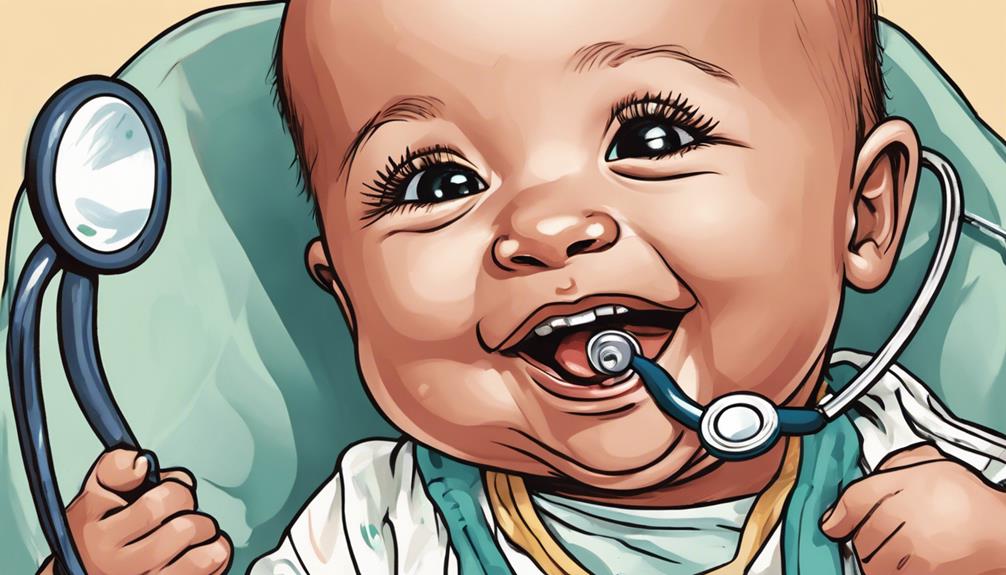
How can you guarantee your baby's dental health is off to the best start? Start by scheduling that first dental visit by age 1 or right after the first tooth erupts. Pediatricians recommend this to keep an eye on your baby's oral health and development.
Before those tiny teeth appear, clean your baby's gums with a soft cloth. As soon as the first tooth comes in, begin brushing with a soft-bristled toothbrush.
Using a smear of fluoride toothpaste is vital for promoting good dental hygiene from the get-go. This helps prevent tooth decay and strengthens enamel, setting the stage for a lifetime of healthy teeth.
Regular dental check-ups are essential, as they confirm that your baby's teeth are developing correctly and help establish a dental home for ongoing care.
Additionally, pediatricians can apply fluoride varnish after the first tooth appears, giving an extra layer of protection against decay.
Frequently Asked Questions
What Are the Most Common First Teeth for Babies?
When you're curious about babies' first teeth, you'll find that the lower central incisors usually emerge first. They typically appear between 6 to 10 months, followed by upper central incisors around 8 to 12 months.
In What Order Do Babies Teeth Come Through?
Imagine a tiny treasure chest slowly revealing—first, the lower central incisors appear, followed by the upper ones, then lateral incisors, molars, canines, and finally, the second molars, creating a beautiful smile over time.
Can Baby Teeth Come in Out of Order?
Yes, baby teeth can come in out of order. Some infants might experience variations due to genetics or health factors. Just keep an eye on their dental development and consult a pediatric dentist if needed.
What if Baby Gets Side Teeth First?
Side teeth showing first? Don't despair! It's not uncommon. Just keep an eye on your baby's oral hygiene and consult a pediatric dentist to guarantee everything's developing properly. Each child's teething journey is unique!
What Is the Typical Order of Baby Teeth Eruption?
The teeth cutting order in babies follows a predictable pattern. Typically, the bottom two front teeth (central incisors) are the first to come in, followed by the top two front teeth. Then the lateral incisors, first molars, canines, and second molars follow in that order.
What Are the Typical Order of Baby Teeth Eruption?
The typical order of baby teeth eruption can vary, but generally, the lower central incisors are the first to appear, followed by the upper central incisors. Next, the lateral incisors, first molars, canines, and second molars will erupt in that order. This sequence determines which teeth have baby teeth.
Conclusion
In summary, teething can be a challenging time for both you and your baby, but knowing what to expect can make it a little easier.
Typically, those first teeth make their debut around six months.
Keep an eye out for signs, and don't hesitate to manage any discomfort.
Remember, this too shall pass, and soon enough, your little one will be flashing a bright smile with their new pearly whites.
You've got this!
